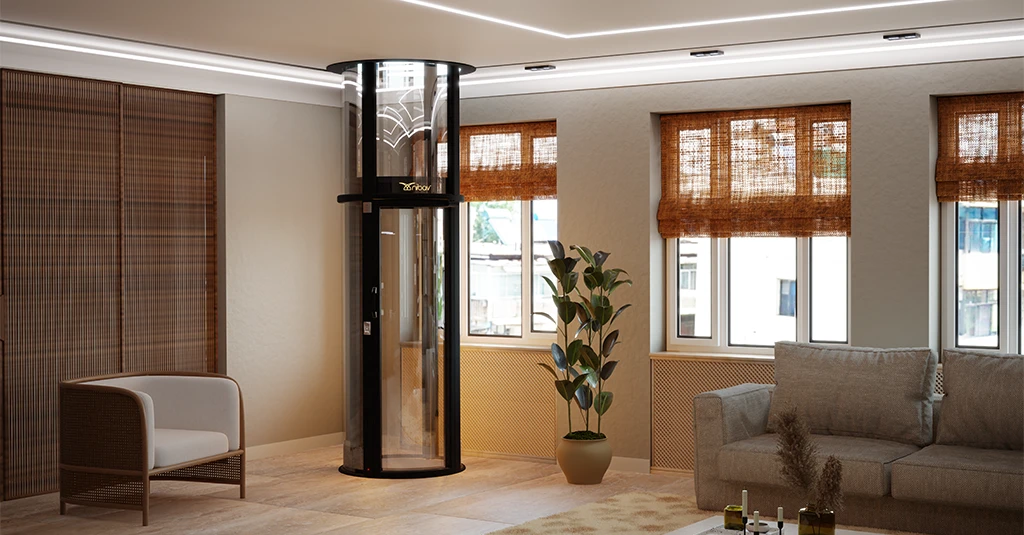
Table of Contents
Introduction
Home elevators are often disregarded in the search for a useful and pleasant place to live. Though historically seen as a luxury addition, there are many health advantages that are fast gaining their respect. Beyond just convenience, house elevators are very important for improving mobility, accessibility, and general well-being for people of all ages. Emphasizing how they may change lives, increase independence, and bring peace of mind, this blog article investigates the many health advantages of building a home elevator.
Increased Mobility for All Ages
Mobility is essential for daily life and influences not only physical but also mental and emotional well-being. From young couples to older adults, home elevators let everyone travel between levels, simplifying their house navigation. For those aged, accidents or health problems might make movement more difficult.
A vacuum elevator helps older people navigate between floors without worrying about hurting themselves or falling. Family members may visit many levels without the physical barrier of stairs, promoting more active lives. For folks who may normally feel limited to one house floor, this improved mobility helps them feel independent and can greatly increase confidence.
Improved Accessibility for Wheelchair Users
Negotiating a multi-level property might be scary for those who rely on wheelchairs. Conventional staircases are a major obstacle limiting access to kitchens, toilets, and bedrooms—all important spaces. Wheelchair users may reach all parts of their house without difficulty thanks to home elevators, which provide a perfect solution.
Furthermore, many contemporary residential elevators include large doors and roomy interiors for different mobility equipment. Wheelchair users find life simpler because of this accessibility, which also promotes home inclusiveness. Family members may get together free from concern about whether everyone can comfortably use common areas.
Less Physical Strain on Caregivers
As they help people with mobility issues, caregivers can experience great physical strain. For those who lift or assist others up and down stairs, caregivers may suffer injuries, chronic discomfort, and exhaustion. Putting up a house elevator can help greatly reduce this load.
Caregivers can securely and quickly move people using an elevator, lowering the danger of damage to either party. This simplicity of movement lets caregivers concentrate more on providing emotional support and excellent care than on physical effort. Home elevators help provide a more caring environment by reducing the physical responsibilities of caretakers.
Enhancing Mental Well-being and Independence
Mental health depends on freedom, especially for physically limited people. A home elevator helps one be more free to move throughout the house, promoting autonomy. Seniors or those with impairments need this empowerment as it helps them control their daily activities and routines.
The ability to negotiate the house without aid may greatly boost self-esteem and allow one to feel less powerless. This freedom enables people to participate in activities they like without depending on others, particularly for mental health. Studies have shown that better mental health outcomes—including reduced rates of despair and anxiety—correlate with more autonomy.
Furthermore, being able to organize events or engage in family activities outside of one level of the home encourages social interaction—a necessary component of mental health. Regular social interaction is well established to help against loneliness and isolation, elements that may seriously compromise mental health.
Energy Saving and Lowering of Fatigue
Climbing stairs may be physically taxing, particularly for people with mobility problems or chronic weariness. Home elevators save energy for fun activities by removing the need for taxing physical effort. Seniors or those with chronic diseases especially benefit from this, as they could become tired quickly and must rest more often.
Reducing the energy used in everyday motions helps people to participate more completely in life, pursue interests, and socialize with friends and relatives. This change improves physical condition and encourages a more active and contented way of life.
Improved Safety Measures for Harmony of Mind
Any home’s priority is safety, particularly for individuals with mobility issues. Modern residential elevators have sophisticated safety mechanisms meant to stop mishaps.
- Emergency Stop Buttons: Emergency stop buttons that let users stop the elevator should anything go wrong.
- Safety Sensors: Safety sensors in the elevator shaft find obstacles to stop mishaps.
- Battery Backup Systems: Systems for battery backup guarantees operation amid electricity blackouts.
These safety elements provide peace of mind for users and their families. Knowing that there is a secure path to negotiate the house helps people overcome their anxiety and dread, thereby enabling their free and confident movement.
Easy, Minimal Impact Installation
The way contemporary house elevators are installed is among their most pleasing features. Technological developments have produced designs requiring less building, reducing the disturbance during installation.
Many elevators may be placed in existing locations without requiring major renovation. This allows homeowners to improve their living areas without having major makeovers. The simplicity of installation also allows homeowners to start immediately enjoying the health advantages of owning an elevator in their house.
Conclusion
Home elevators are no longer just a luxury; they are a necessary feature that improves the quality of life for people of all ages and abilities. From more mobility and better accessibility to less physical strain on caregivers, residential elevators provide broad health advantages. They advance mental health, independence, peace of mind, safety, and comfort.
The value of these practical and health-promoting solutions will only increase as our population ages and more people want to keep their independence in their homes. Accepting the advantages of a home elevator can help every family member live a better, more independent life. Making a house elevator investment now will open the path for a more accessible and contented future.
